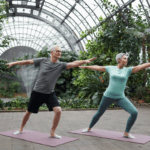Coming Soon: E-book about Kundalini Yoga - Sign up here to be among the first to get it!
Embarking on a yoga journey introduces you to movements that not only test but also reshape your physique in surprisingly profound ways. Among these, lizard pose stands out as a powerful hip opener that offers more than just flexibility benefits. This manual is meticulously designed to assist you in perfecting the lizard pose, comprehending its different forms, and seamlessly integrating it into your regimen.
You’ll learn step-by-step instructions for getting into lizard pose correctly to avoid injury and make the most of its benefits. We also cover modifications to adapt the pose to different levels of flexibility, ensuring everyone can experience its advantages regardless of their starting point. Plus, we explore additional hip-opening yoga poses for a well-rounded routine.
Table of Contents:
- What is Lizard Pose?
- Step-by-Step Instructions for Lizard Pose
- Modifications and Variations of Lizard Pose
- Benefits of Practicing Lizard Pose Regularly
- Precautions and Safety Tips for Practicing Lizard Pose
- Exploring Hip-Opening Yoga Poses Beyond Lizard Pose
- How To Integrate Props Into Your Practice Of The Lizard Pose
- Personal Experiences With Lizard Pose: From Beginners To Advanced Yogis
- FAQs in Relation to Lizard Pose
- Conclusion
What is Lizard Pose?
Utthan Pristhasana, known in the yoga world as Lizard Pose, plays a crucial role in improving the agility of one’s hips. This intermediate-level position delves deep into opening the hip flexors and stretching thigh muscles while keeping the core engaged. This posture isn’t merely a physical extension; it also sets the stage for enhanced stress regulation via contemplative exercise.
For those stepping onto their yoga mat with curiosity about the benefits of Lizard Pose, it offers more than meets the eye. Regular engagement in this posture can significantly improve your range of motion around the hips, providing relief from tightness due to prolonged sitting or intense physical activity.
Step-by-Step Instructions for Lizard Pose
To start practicing Lizard Pose effectively, begin by positioning your left foot forward in a low lunge stance ensuring that your knee does not overshoot your toes – an essential tip to avoid injury. Your arms should remain straight with hands firmly planted on either side of your left foot to maintain balance and alignment.
This precise setup aids in achieving a deep stretch across the outer edge of your left hip and throughout leg muscles without putting undue pressure on any single area. The importance lies not only in entering but maintaining this pose with mindful attention to body alignment – hips level, chest open, and engaging core strength for stability.
Modifications and Variations of Lizard Pose
If you find yourself struggling with tight hips or if the knee feels uncomfortable during practice, don’t hesitate to modify lizard pose using props like folded blankets under knees or blocks beneath hands for added support. For yogis looking to deepen their experience, exploring variations such as Twisted or Flying lizard introduces an additional layer challenge while still reaping all foundational benefits associated with regular practice. Discovering these modifications allows each individual to cater poses to fit unique body needs, avoiding the risk of injury and promoting safe growth within the personal yoga journey.
Lizard Pose, or Utthan Pristhasana, is your go-to for better hip flexibility and stress relief. Start in a low lunge, keep that core tight, and remember to use props if you need them. It’s all about finding what feels good for your body.
Step-by-Step Instructions for Lizard Pose
Positioning Your Left Foot
To start with the lizard pose, known as Utthan Pristhasana in Sanskrit, you’ll need to get your left foot correctly positioned. This begins by stepping your left foot forward into a low lunge. Make sure that your knee is directly over the ankle and not pushing past your toes. Ensuring your knee aligns directly above your ankle is key to preserving equilibrium and mitigating stress on the joint.
This alignment helps activate the hip flexors and thigh muscles while keeping pressure off of your knee if it feels uncomfortable at any point during practice. Remember, every individual body differs; what works perfectly for one might need slight adjustments for another.
Aligning Your Arms and Hands
Once you have settled into a comfortable stance with your left leg forward, focus next on aligning arms straight down from shoulders so hands are firmly planted on either side of this lead foot. Engaging through both palms evenly lets you distribute weight throughout all four points—both hands and feet—which stabilizes posture further.
Maintaining strong arm positions aids in deepening stretch across hips level without putting undue stress upon them or compromising form elsewhere along spine due to imbalance caused by sagging shoulders or elbows bending outwards instead staying tucked closely alongside ribcage area where they belong during execution phase itself within overall sequence flow movement pattern followed here today together as part our learning journey towards mastering these foundational yoga poses like lizard step-by-step properly each time we roll out mats no matter if practicing alone home setting maybe even leading class environment being certified instructor yourself someday soon hopefully after completing training course successfully first obviously before teaching others how do same thing safely effectively long term basis going forward future sessions held wherever they may take place worldwide globally speaking perspective wise essentially end day goal aim target reach achieve collectively group whole ideally scenario case happens come fruition eventually fingers crossed wishing best luck everyone involved process becoming better versions themselves through power transformational practices such dynamic stretching exercises including but not limited solely mentioned above example given context discussion topic hand currently under review consideration present moment time frame reference point starting line beginning journey adventure awaits us embark upon discovery new heights personal growth development stages life experiences shared amongst peers community alike strong bonds formed connections made lasting lifetime memories created unforgettable moments cherished forever heart soul mind body spirit aligned harmony peace love joy happiness prosperity abundance success fulfillment satisfaction achieved realized dream reality manifested tangible results seen felt heard touched tasted smelled senses fully engaged immersive experience altogether complete package deal offer special limited period don’t miss out opportunity knocking door answer call action required partake festivities celebration commence forthwith immediately post haste delay hesitation wait longer necessary seize control destiny manifest own fate universe conspiring favor believe magic happen open eyes see beauty world around embrace change adapt evolve grow stronger resilient. Let’s seize this opportunity, immerse ourselves in the transformative journey of yoga, and let it lead us to a life filled with fulfillment and harmony.
Dive into lizard pose with your left foot forward, ensuring knee alignment over the ankle to protect joints. Plant hands firmly on either side of your foot for stability, and let this foundational yoga move deepen hip flexibility and strength. Remember, adjustments may be needed as every body is unique.
Modifications and Variations of Lizard Pose
Lizard pose, or Utthan Pristhasana, is a fantastic way to enhance hip flexibility. But let’s face it: not every body bends the same way. Hence, adapting the pose becomes a pivotal move for novices aiming to gently introduce themselves to its benefits. Meanwhile, advanced practitioners might crave more intensity with variations like Twisted or Flying Lizard.
Modify Lizard Pose
If your hips are tight or if you’re just starting out, don’t fret—modifying lizard pose can help prevent strain and make the posture accessible. Placing a folded blanket under your knee feels softer if the ground feels too hard. Another tip? If extending your arms fully makes you tense up, try resting on forearms supported by yoga blocks. Adjusting this way allows you to maintain an open chest and even hips, ensuring your hip flexors still receive a thorough stretch.
To explore these options further, check out how different props can aid in modifying lizard pose here.
Variations for More Intensity
Once you’ve got the basics down pat and want to challenge yourself further, step into Twisted Lizard or take flight with Flying Lizard Pose variation. In Twisted Lizard, turning towards your bent leg opens up an opportunity for a greater twist through the spine while engaging those thigh muscles even more intensely.
Flying lizard asks for courage as much as flexibility—lifting off requires strong core engagement but rewards with exhilarating freedom in practice.
Dive deeper into challenging yet rewarding variations like flying lizard here.
Benefits of Practicing Lizard Pose Regularly
Lizard pose, known in Sanskrit as Utthan Pristhasana, is a powerful hip opener that offers numerous physical and mental health benefits. This intermediate-level yoga pose enhances hip flexibility, making it an essential part of any yoga practice.
Integrating this posture into your daily regimen notably amplifies your hip’s flexibility, thereby broadening their movement spectrum. With regular engagement in the lizard posture, you’ll find a reduction in stiffness and an enhancement of movement fluidity. It’s particularly beneficial for those who spend long hours sitting or have limited activity throughout their day. For more insights on the fundamentals and benefits of lizard pose, check out this detailed guide.
In addition to its physical perks, regular practice has been shown to reduce stress levels effectively. The deep stretch engages not only your quad stretch but also targets your hip flexors—areas where many people hold tension due to emotional or physical reasons.
Beyond improving hip flexibility and offering a great quad stretch, lizard pose serves as one of the most effective hip openers you can integrate into your daily yoga regime. Discover how fellow practitioners are weaving this posture into their daily practice. Whether you’re looking to enhance athletic performance or simply aiming for a deeper sense of relaxation within your body, regularly engaging in this posture could be transformative.
Safety should always come first; thus modifications are encouraged for beginners or those with tighter hips to avoid strain while still reaping all these wonderful benefits without risking injury.
Precautions and Safety Tips for Practicing Lizard Pose
Delving into yoga, particularly the lizard pose for hip flexibility, requires a focus on maintaining your well-being to fully reap its rewards.
Modify the pose if you have tight hips to prevent strain
Tight hips are common but don’t let them hold you back. Adjusting your stance can greatly diminish the chances of sustaining an injury, ensuring a safer practice. For instance, placing a folded blanket under your knee or using blocks beneath your hands can help maintain proper form without straining your muscles. This approach ensures everyone gets to experience lizard pose regardless of their flexibility level.
To further protect yourself from discomfort or potential harm, listen closely to what your body tells you during each session. Pushing too hard could lead not only to short-term pain but also long-term issues that nobody wants.
Ensure your knee doesn’t extend past your toes to avoid injury
A critical aspect many overlook in lizard pose is the alignment of their front knee; it should never shoot past the big toe on that foot because this puts unnecessary pressure on both knees and joints—something we definitely want to avoid putting ourselves through when aiming for a deep stretch in our hip flexors and leg muscles.
Maintaining hips level with each other will give stability throughout this posture while keeping core engaged helps distribute weight evenly across legs so no single area bears undue burden which might result in discomfort or worse yet—an injury waiting around next bend.
Exploring Hip-Opening Yoga Poses Beyond Lizard Pose
While the Lizard Pose, or Utthan Pristhasana, is a go-to for many seeking to enhance hip flexibility, there’s a world of other poses offering similar benefits. Let’s delve into some alternatives that could round out your practice.
The Pigeon Pose, known as Eka Pada Rajakapotasana in Sanskrit, targets not only the hips but also the thighs and groin. Ideal for individuals enduring extended periods of sitting, this remedy aids in alleviating stiffness stemming from continuous lack of movement.
Eka Pada Galavasana or Flying Crow offers an advanced variation that incorporates balance and strength alongside deep hip opening. Engaging your core, this stance simultaneously stretches the hip flexors and the outer boundaries of your leg muscles, pushing you to balance strength with flexibility.
A less commonly practiced yet highly beneficial pose is Twisted Lizard; it adds a twist to the traditional Lizard stance which intensifies the stretch on the hips while engaging thigh muscles more deeply.
To modify any yoga hip opener like these when starting out or if experiencing discomfort, consider using props such as folded blankets under knees or blocks beneath hands for added support—this ensures safety without compromising on depth. Yoga Journal provides step-by-step instructions on how to integrate props effectively into these practices.
Safety remains paramount with all forms of exercise including yoga; hence paying attention to body signals and avoiding pushing too hard into poses is essential—a key reminder especially when exploring new movements within one’s routine.
How To Integrate Props Into Your Practice Of The Lizard Pose
If you’ve ever felt like the lizard pose is just out of reach, props might be your answer. Utilizing accessories such as blocks or neatly folded blankets can majorly elevate the practice of this hip-loosening pose, making it achievable for yogis across various stages of limberness.
A common challenge many face with the lizard pose, especially after prolonged sitting, is tightness in the hips and thighs. Placing a folded blanket under your knee can offer comfort and support if the pressure on your knee feels uncomfortable. Tweaking it a bit by slipping a folded blanket under your knee helps shift your attention towards sinking into the stretch instead of fussing over any knee pain.
Blocks are another game-changer for practicing lizard pose effectively. By placing them under your hands, they help keep your chest open and spine long even if reaching down to the mat doesn’t feel accessible today. This position encourages proper alignment while still getting that great stretch in the hip flexors and thigh muscles.
It’s also worth noting that integrating props into poses such as downward dog before transitioning into lizard can prepare your body better by loosening up tight areas resulting from modern-day lifestyle habits like prolonged sitting at desks.
To ensure safety when incorporating these tools into practice consider reading about precautions specifically for lizard pose. Remembering these tips will let you enjoy all its benefits without risk of injury due to improper form or overstretching less flexible parts of our bodies.
Personal Experiences With Lizard Pose: From Beginners To Advanced Yogis
The journey into the Lizard Pose, or Utthan Pristhasana, unfolds uniquely for every yogi. Embarking on the Lizard Pose journey, individuals discover it either as a seamless step towards enhancing their hip suppleness or as a powerful affirmation of transcending bodily constraints and cherishing the distinctiveness of their physique.
Beginners often encounter challenges with tight hip flexors that make entering this pose feel daunting. Yet, through modifications like using a folded blanket under the knee or starting from downward-facing dog to ease into it gradually, they find ways to adapt. This adaptation is crucial because pushing too hard can lead not only to discomfort but also negative effects such as strain on the leg muscles or knees.
Advanced practitioners experience lizard pose differently. They explore variations like twisted lizard or flying lizard that demand more from their thigh muscles and core engagement while ensuring their hips remain level and the chest stays open—a balance between strength and flexibility. However fascinating these advancements are though there’s always room for humility; even hour-certified yoga instructors stress the importance of listening closely to your body’s signals to avoid risk injury.
In every yoga session, slipping up is a natural step in the journey of growth. Common pitfalls include letting your front knee extend past your toes or forgetting to keep your back leg engaged which can both be addressed by revisiting common mistakes in Lizard Pose. Navigating through yoga, it’s clear that mastering the right stance isn’t only about nailing a pose; it’s equally critical for dodging potential injuries.
FAQs in Relation to Lizard Pose
What is the Lizard Pose good for?
Lizard Pose opens up your hips, stretches hamstrings and quads, and can help with lower back pain.
Why is Lizard Pose so difficult?
This pose challenges many due to tight hip flexors or hamstrings from sitting all day or lack of stretching.
How to do Lizard Pose for beginners?
Start in a low lunge. Drop both hands inside your front foot. Keep the back knee lifted or lowered for more support.
What is dragon vs Lizard Pose yoga?
Lizard focuses on hip flexibility; Dragon intensifies this by adding more stress on the hips and quadriceps.
Conclusion
Mastering lizard pose takes time. But now, you know how to start, adjust for your level, and keep safe.
Dive into variations if the standard stretch doesn’t hit the spot. Remember, twisted or flying lizard might be your next challenge.
Use props if necessary. A folded blanket or block can make a world of difference in comfort and accessibility.
Above all, make it a habit to practice frequently. Flexibility comes with consistency; this pose is no exception.
Lizard pose opens more than just hips; it’s a gateway to deeper yoga practice. Incorporate these pointers into your quest for enhanced suppleness and awareness, advancing on the path of yoga.
Sign up for our newsletter to stay updated with the latest articles, or ask me anything!



